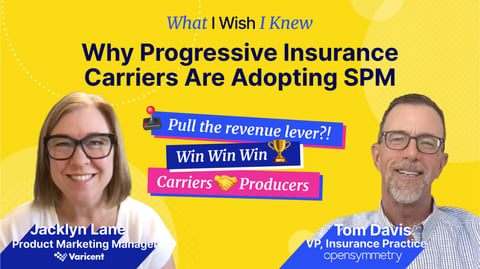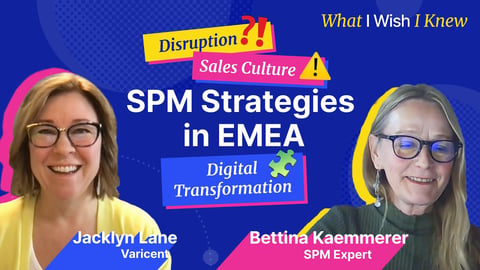In the past two decades, Sales Performance Management technology has undergone a remarkable transformation – from calculator to dot connector. We were fortunate to host a seasoned sales vet who has actively participated in it all – Varicent’s very own Product Marketing leader James Mulligan.
Continuous Sales Planning
Our conversation with was chock full of insightful gems, with a focus on the rise of continuous sales planning, the power of predictive analytics and scenario modelling, and how you can take your sales performance management to the next level.
In this blog, I’ll recap some of the insights shared in the episode, including:
Sales Performance Management Tools Over the Past 20 Years
Sales Performance Management Transformation: Case Study
What’s Next? Predictive Analytics and Connected Go-to-Market Planning
Sales Performance Management Technology Unlocks Collaboration
Connected Sales Data Enhances Decision-Making
How-to Effectively Manage Change
Artificial Intelligence in Sales Performance Management
Missed the What I Wish I Knew LinkedIn Live event? You can listen to the full episode on Spotify or Apple Podcasts. And follow us on LinkedIn, to stay in the know about upcoming What I WIsh I Knew live episodes.
Sales Performance Management Tools Over the Past 20 Years
At a time when it was novel to have your pay directly deposited into your bank account, manual calculations and spreadsheets were common. Businesses relished the power and efficiency of a solution that could handle complex incentive compensation formulas. In retrospect, these solutions were sophisticated calculators.
Incentive Compensation has evolved to be the foundation on which go-to-market engines continue to automate and add value through process and technology integration combined with data-led insights.
Calculator Stage
Initially, the focus was on accuracy and timeliness in incentive calculations. Basic tools were used, often manually, to ensure fairness and efficiency.
Automation Stage
However, with advancements in technology, automation became critical. Specialized software solutions like Sales Performance Management (SPM) emerged, optimizing the calculation process, expanding offerings like territory management to improve efficiency.
Value Stage
As incentives matured, the focus shifted towards adding value, including generating insights, comprehensive reporting, and maximizing ROI on investments.
The Current/Future Stage
Today, the integration with other sales processes, like go-to-market planning, takes centre stage. This means leveraging AI and advanced analytics across the entire sales ecosystem, ensuring alignment, and maximizing outcomes. Get your first look at the current and future stages of sales performance management solutions by booking a demo with a Varicent expert.
Sales Performance Management Transformation: Case Study
An illustrative example of a Varicent customer's SPM journey highlights the transformative power of evolving beyond calculations alone. Initially, this customer faced challenges with accurate and timely incentive calculations. The focus was on resolving the pain point of manual calculations to ensure accuracy and efficiency.
As automation eased this pain, the customer shifted their focus to improving reporting, engagement, and ROI representation related to incentives. They recognized incentives as a powerful tool for engaging, communicating, and influencing behavior.
This shift towards front-end engagement resulted in significant increases in employee engagement and improved results. Now, the customer is exploring the potential of AI, leveraging it as a strategic tool to further drive engagement, enhance decision-making, and optimize outcomes.
What’s Next? Predictive Analytics and Connected Go-to-Market Planning
For organizations that have just nailed down incentive comp, often their next problem to solve is ‘seeing around corners’. Anticipating future challenges and opportunities is crucial in today's dynamic business environment.
Artificial Intelligence (AI) plays a significant role in this regard by offering predictive capabilities to foresee market trends, customer demands, and competitive landscapes. By using advanced analytics, organizations can simulate various scenarios and make more informed choices, minimizing uncertainties, and mitigating risks.
Effective go-to-market planning requires seamless integration between various processes. This includes connecting incentives with broader planning efforts, ensuring alignment between objectives, resources, and execution.
The biggest challenge often faced by Compensation Administrators is unbalanced territories and unfair quotas that distract and demotivate sellers. Without good comp plans, territories, and targets working together, the effectiveness of the go-to-market strategy is compromised.
For more discussion on how planning is a connected process, check out this clip.
3 Key Outcomes that Organizations Want from the Go-to-Market Planning
Recently, Varicent collaborated with the Sales Management Association on a recent report that explores this new era of go-to-market planning. The study revealed three key outcomes that companies are looking for in their go-to-market strategies.
1. Unlock Collaboration
Effective collaboration is crucial for breaking down silos and enabling teams to plan and execute more effectively together. By leveraging purpose-built Sales Performance Management tools and technology, organizations can streamline operations, gain enhanced insights, and make more informed decisions in their go-to-market strategies.
2. Enhance Decision-Making
Access to accurate and timely data is pivotal for successful planning efforts across goal setting, strategy development, and compensation. Pulling disparate data into a central location, and tools to clean and prepare data, leaders have a new super-power. By activating data-derived insights, organizations can fuel better decision-making and outcomes.
Inaccurate data has grave consequences for sales organizations. James dropped a staggering stat that shows the impact disconnected data can have in this clip.
As James said, better data, better decisions.
3. Effectively Manage Change
Change is the new constant. All sales organizations face change, but it’s those organizations that embrace change – those that plan for change - are the ones that get ahead. The status quo is no longer an option for success, even in the short term. What does embracing change look like? Leveraging sales performance management tools to enhance foresight, streamline processes and ultimately lead to better adaptability increases the likelihood of achieving your sales goals.
James discusses why making change a core part of your organization’s DNA is a winning strategy in this clip.
Artificial Intelligence in Sales Performance Management
AI is on sales leaders’ minds – the big question is, what problem can AI solve for leaders using sales performance management solutions?
Today, AI-led insights can be leveraged when navigating changing markets, customers, and buying patterns. Even better, the longer AI is in place, the longer it works with a set of data, the more accurate the insights become. The combination of human intelligence and artificial intelligence has the potential to accelerate technological change and revolutionize the entire sales ecosystem in a shorter time span.
As mentioned earlier, predictive AI, when fed connected, accurate data, can help sales leaders foresee market trends, customer demands, and competitive landscapes.
Then there is scenario modelling. Think about something like a Monte Carlo simulation. With advanced analytics, you can now run tens of, or hundreds of thousands of scenarios through a rule, a metric, or a scenario and effectively understand statistically what is most likely to occur. This enables decision-makers to simulate various outcomes and make more informed choices, effectively minimizing uncertainties and mitigating risks.
For a more in-depth discussion on the topic of AI and SPM, check out the very first episode of What I Wish I Knew featuring Joel Shapiro.
Successful Organizations Have a Connected Path to Revenue
Our conversation made it clear – this disruptive market is even more challenging if you have a disconnected go-to-market engine. And there is data to back it up.
Download the Sales Marketing Association x Varicent report to explore data from hundreds of sales professionals, how high performing organizations are making data-informed decisions, and an in-depth look into how connected sales planning take on the challenges of this change-intensive market.




